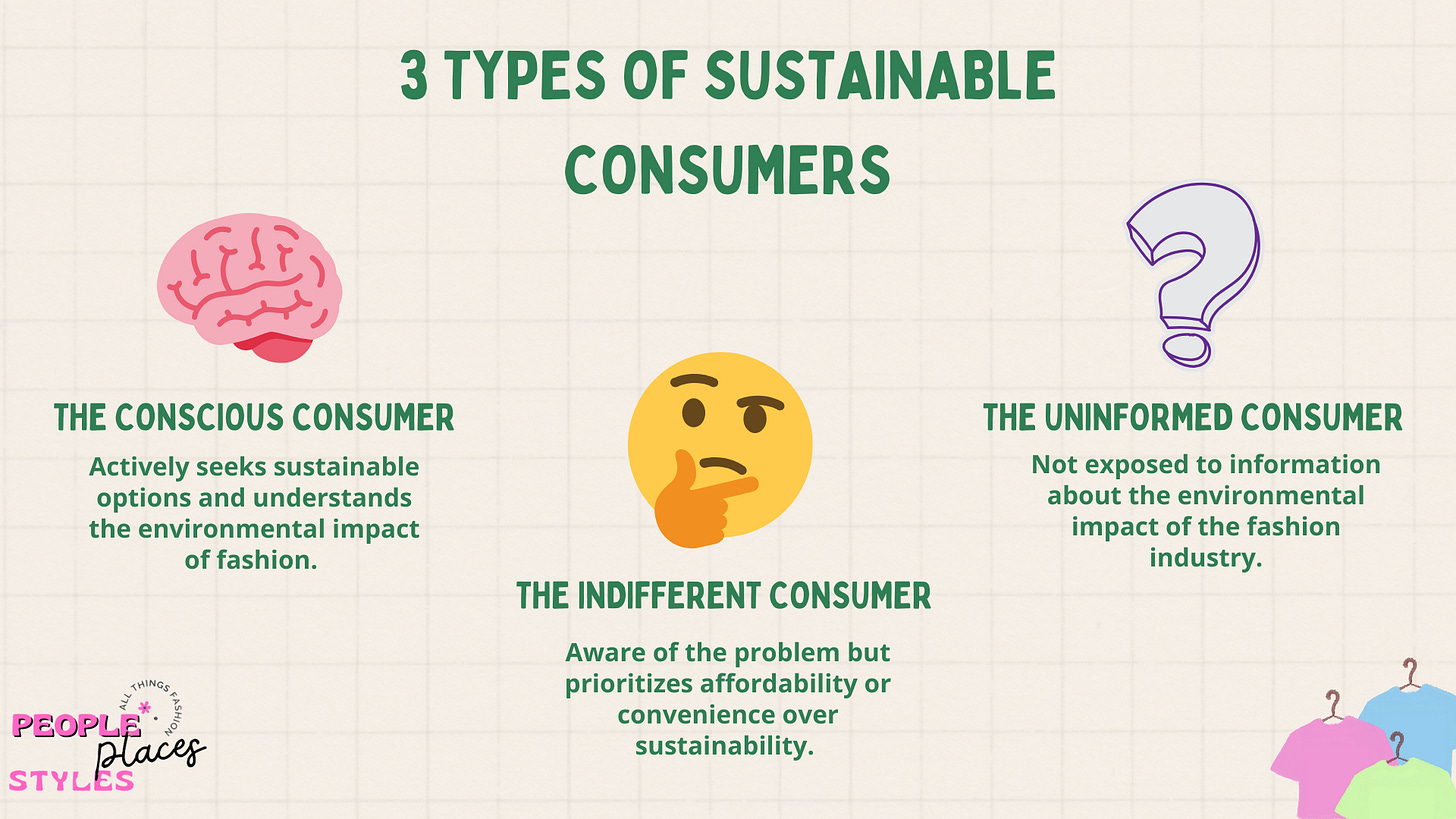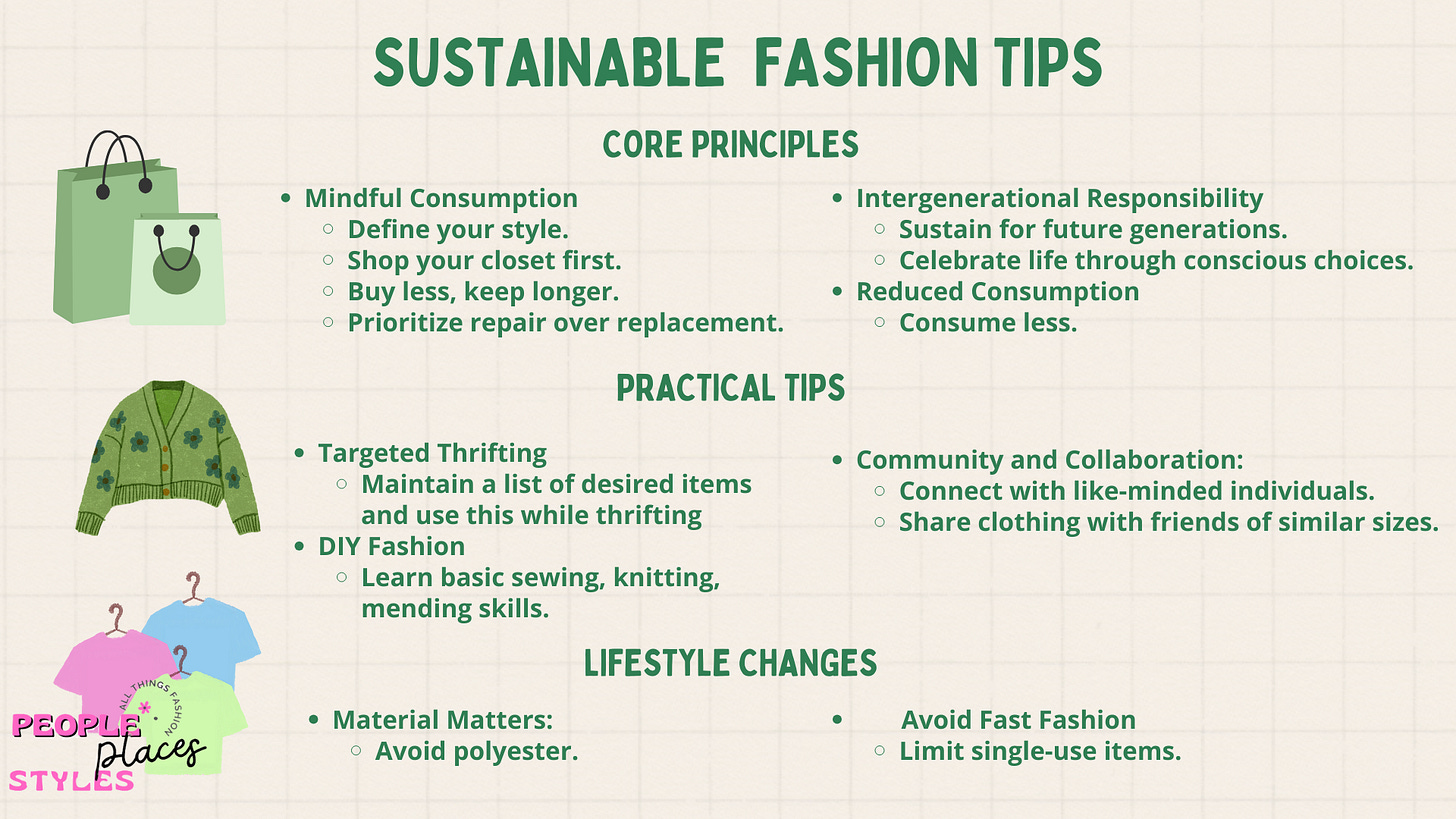Reduce, Reuse, Recycle…but make it Fashion
A Guide to Embracing Sustainability in Your Closet from Sustainable Fashion Advocates and a Recovering Shopaholic
Hello, My name is Imiyah and I am a recovering shopaholic.
*Crowd whispers* hi imiyah
I’ve spent most of my adulthood purchasing clothes or beauty products at an alarmingly fast rate, spending hours scouring the internet for things I want and always waiting on a package to be delivered. Not that long ago, if someone asked me what my hobbies were, my first response was “...shopping”. However, recently there has been a shift in my habits. I became more conscious of what I was buying, where I was buying it from, and most importantly the VOLUME I was buying at.
I'm all about sustainable fashion, but let's be real—I'm no expert. That's why I reached out to my dear friend, Iman Usmani (imany_sewnami), a sustainability superhero. By day, she's a sustainability consulting wizard, but by night (and weekends), she's a crafting queen, business owner, and co-founder of the Lucky Olive (theluckyolive_).
I wanted to know the quick and clean scoop on sustainable fashion and how we can all become one step closer to dressing green. So today’s article is a mash up of an interview held with Iman, an event I checked out hosted by the Lucky Olive, and just a lil’ good ol fashioned research.
“To understand someone’s present, you must explore their past”
Iman’s interests in ethical fashion can be traced all the way back to her childhood. Iman was raised by her Pakistani immigrant parents in North Carolina and is the eldest daughter of three. (I've met her family and they are some of the coolest people ever). Her family followed sustainable practices before it was popular. Her grandmothers were avid knitters, unknowingly teaching her how cool it is to be able to make something from scratch. Her mother kept her most prized possessions in a glass case, unknowingly teaching her to take pride in her belongings. Iman learned how to thrift at a young age, and at the time she may not have known it, but she was developing an appreciation for the longevity and sustainability of well-made garments.
Born in the 1990’s, Iman’s life has coincided with the rise of fast fashion. Fast fashion can be defined as inexpensive clothing produced rapidly by mass-market retailers in response to the latest trends. As production rose, consumption habits did as well, with “the average consumer buying 60 percent more clothes in 2014 than in 2000, but keeping each garment for half as long” (McKinsey).
As Iman was getting older, there was a noticeable difference in what she was being taught at home and what she was seeing in the world around her. In high school, Iman remembered watching a documentary titled ‘The True Cost’ by Andrew Morgan. ‘The True Cost’ focused on “the clothes we wear, the people who make them, and the impact the industry has on our world, the environment, the society, and the workers” (Wikipedia).
There was one segment of the documentary particularly that left a lasting impression on Iman and that was none other than learning about the tragedy of the Rana Plaza building collapse outside of Dhaka, Bangladesh. Rana Plaza housed five garment factories that manufacture clothes for many international clothing brands in Europe and North America. “On 24 April 2013, the building came crashing down, killing 1,134 people and leaving thousands more injured. After investigation, it was discovered that the building had too many floors and too much heavy equipment for the structure to withstand” (Wikipedia). Iman's South Asian heritage allowed her to connect deeply with the plight of the injured garment workers. She empathized deeply with their suffering and the hardships faced by countless others who continue to work in suboptimal conditions.
These early lessons in sustainability laid the foundation for Iman's passion for sustainability and becoming an advocate for ethical fashion. Her interests have most recently led her to co-founding the Lucky Olive collective, whose mission is to build a community for conscious living. Lucky Olive originated from her colleague seeing a lack of events focused on slow fashion, resources, and community during Climate week.
I was invited to their first event “a one stop shop for loving your wardrobe” that consisted of a panel of 6 people associated with fashion sustainability followed by restyling and mending booths. I was so impressed by the diversity of the panelists, I want to share a couple of the panelists backgrounds:
Nancy Rhodes of @alternew_official, with nearly 20 years of experience designing footwear, (an extremely non-sustainable product), is now focused on a mission to accelerate the fashion industry’s transition to the circular economy (think alterations or repairs).
Izzy, @isaboko_ who is a fashion designer and founder of Isaboko, a brand based on radically sustainable systems, and solarpunk ideas. Who became “radicalized” as a child after seeing the amount of waste produced during a junior project runway challenge.
What is something that most people don’t know or realize about sustainable fashion?
Is sustainable fashion a misunderstood movement in 2024? While many recognize the fashion industry's environmental impact, there's a surprising amount we might not know about truly sustainable practices. In my opinion are three key groups of consumers:
Readers, ask yourselves: Which one are you? It's important to understand our individual roles in the sustainability movement, not in a judgmental way, but to recognize the impact we're making. I personally am somewhere between the indifferent and conscious consumer myself. To help you understand where I'm at, I am ashamed to frequently buy from the big tree company but I don’t order from Shein.
For conscious consumers, I hope this article resonates. For those who are indifferent or uninformed, I encourage you to keep learning with me. One of the primary barriers to the latter groups, as discussed during the panel, is a lack of empathy. Many people believe sustainability is a problem that doesn't directly affect them, and therefore, they feel powerless. However, the truth is more complex.
Iman noted that many people find sustainable fashion inaccessible due to convenience and the perception that it's incompatible with trends. I personally struggle with this feeling, especially when bombarded with fast-fashion trends on social media or “needing” things in two days or less.
The first step to addressing a problem is acknowledging its existence, which isn't always easy. It took me a while to get where I am now. For so long I was in a pattern of buying, buying, buying. I started to notice that I was spending extreme amounts of money on things that I would only end up wearing a few times.
I have come to learn that the real problem I have is what we call “retail therapy”. My shopping patterns closely parallels my mood. When I'm down, I shop to fill the void but there became a time when nothing I purchased made me feel any better. Finding out that a new pair of jeans isn’t going to make all my problems go away was devastating.
Everyone will have different journeys to mindful consumption. Is it because you just love Mother Nature so much? Want to lower your spending? No matter the reason, there are several ways to approach this mindset change.
An idea from one of the panelists is a ‘No New Clothes Challenge’. Choose any period of time, a month or a quarter, and don’t buy anything brand new, and I know what you are going to ask next and yes I think you can still thrift. Another idea was to unfollow social media influencers who are constantly pushing new products and find new ones who “preach” more sustainable consumption ideas. My favorite advice was to start unsubscribing from the company's marketing texts and emails.
What is something that everyday people can do to be more sustainable in their fashion?
“When you know better, you do better” - Maya Angelou
This phrase has a simple and clear meaning to it. I feel that it means that we often make mistakes because we don't know the right way to do stuff. So how can we do better, now that we know better?
Iman believes that “the biggest thing people can do is start by lowering their consumption. There is a misconception that being sustainable has to be an all or nothing approach, which is not true. There are small steps every person can take. Starting with consuming less, shopping your own wardrobe, and thinking about your clothes in a different way. This is the most sustainable way.”
I understand that it can be challenging to resist the appeal of fast fashion brands like Zara or the convenience of Amazon. However, Iman once shared a valuable perspective: if you're going to purchase something from a fast fashion retailer, it's more acceptable if you'll wear it frequently. The real problem lies in buying items for single-use or in excessive quantities.
Those are just a couple of approaches, there are so many ways for you to approach fashion more sustainably, check out this graphic for a few more ideas.
Another pillar of sustainable fashion that Iman practices is embracing DIY and learning how to craft garments. In high school, what began as a casual hobby of learning to knit, unexpectedly transformed her into an entrepreneur, as her quirky hat creations sold for $50 each and her mother even helped her connect with a boutique that could distribute them. Her skills have since expanded to include embroidery, sewing, and crochet. She feels like she has a whole toolbox to feel connected to her clothes. Check out her page, she has made some seriously unique pieces.
I got a little taste of how exciting it can be to DIY at the Lucky Olive event. I intended to go to the mending station to learn how to sew a hole on my favorite pair of thrifted Stussy pants. But I ended up spending time at the restyling section, making bows and brainstorming ideas for other attendees.
Is there anything you are seeing that gives you hope with the future of ethical fashion?
For me, it’s advocates like Iman that gives me hope for a brighter future. Iman has always inspired me with her courageous actions and commitment to sustainable fashion. She builds inclusive communities, educates others, and fosters a non-judgmental space for growth. A prime example is her weekly BIPOC Craft Circles, where she cultivates a safe space for people of color to develop their crafting skills and make long lasting relationships.
I strongly believe there are several people out there that want to take part in this movement but don’t know where to start. So through writing this article I compiled a list of resources and communities to get involved in to learn more! Hope you all join me on this journey :)
Thank you all for reading! And to my dear friend Iman, thank you so much for allowing me to share a part of your story.
Communities:
BIPOC Craft Circle (imany_sewmani): BIPOC halloween craft circle at Cleo’s on 10/30 from 6-8 pm
The Lucky Olive (theluckyolive_): a community for conscious living resources & events
BedStuy Clothing Swap (bedstuy_clothesswap): grassroots grown movement | anti capitalist, pro letting go of tingZz
Fashion Revolution (fash_rev): Global movement for people and planet over profit
FabScrap (fab_scrap): rethinking textile waste! ♻️ providing pickup of unwanted fabric from businesses and engaging local creative communities in reuse
Additional Resources:
Why the New York Fashion Act Could be Transformative for the Fashion Industry - Atmos





I learned a lot from this !